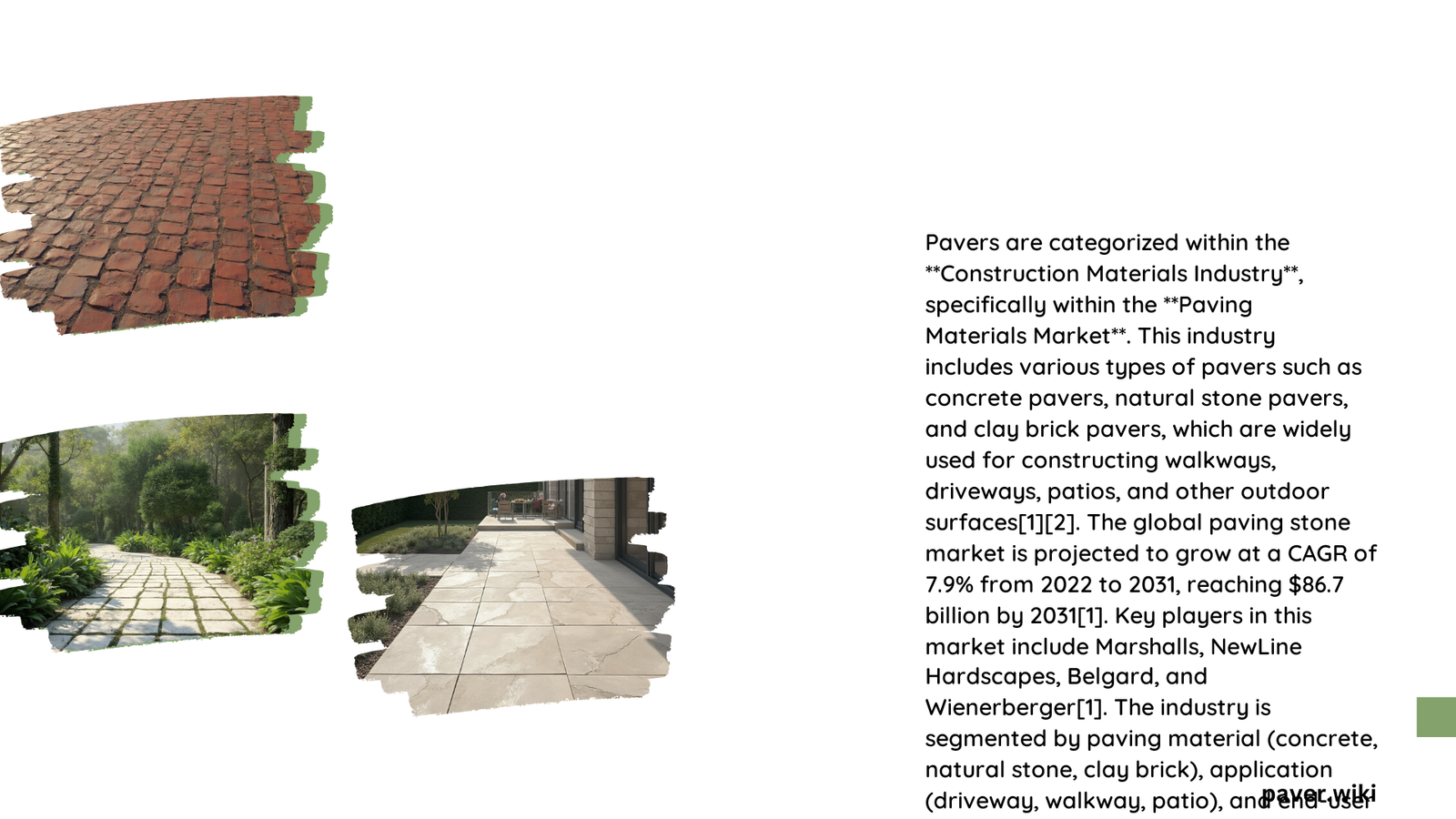Pavers are categorized within the construction and landscaping sectors, specifically under the paving materials industry. This industry encompasses various types of pavers, including concrete, natural stone, and clay brick. The market is segmented based on material types, applications, end-users, and geographical regions. Pavers play a crucial role in both residential and commercial construction projects, contributing to the aesthetics and functionality of outdoor spaces.
What are the Main Categories in the Pavers Industry?
The pavers industry is divided into several key categories:
- Paving Material Types:
- Concrete pavers
- Natural stone pavers (granite, marble, limestone, etc.)
- Clay brick pavers
-
Others
-
Application Areas:
- Driveways
- Walkways
- Patios
- Pool decks
- Gardens
-
Commercial spaces (shopping malls, restaurants, offices)
-
End-User Segments:
- Residential construction
- Commercial construction
- Industrial projects
-
Municipal projects
-
Geographical Regions:
- North America
- Europe
- Asia-Pacific
- LAMEA (Latin America, Middle East, and Africa)
How is the Pavers Manufacturing Process Structured?

The manufacturing process for pavers varies depending on the material type:
Concrete Pavers
- Raw materials: cement, sand, and aggregates
- Production technique: mold and vibration process
- Machinery: vibratory presses, molds
Natural Stone Pavers
- Raw materials: natural stones (granite, marble, limestone, etc.)
- Production technique: cutting and polishing
- Machinery: stone cutting and polishing equipment
Clay Brick Pavers
- Raw materials: clay
- Production technique: mixing, molding, drying, and firing
- Machinery: kilns, molding equipment
What are the Current Market Trends in the Pavers Industry?
The pavers industry is experiencing significant growth and evolving trends:
- Market Growth:
- Global paving stone market projected to reach $86.7 billion by 2031
- Concrete pavers market expected to hit $16,958.5 million in 2024
-
Commercial paving slabs market forecasted to grow to $4.24 billion by 2030
-
Consumer Preferences:
- Increased demand for durable and low-maintenance paving solutions
- Growing interest in outdoor living spaces and landscaping
-
Preference for customizable and sustainable paving options
-
Emerging Technologies:
- Permeable pavers gaining popularity due to ecological benefits
- Advancements in design and surface finishes
What are the Installation Standards for Pavers?
Proper installation is crucial for the longevity and performance of pavers:
- Guidelines:
- Compacted base requirement for stability
- Proper drainage considerations
-
Specific patterns for laying pavers
-
Techniques:
- Interlocking or pattern-based installation
-
Leveling, compacting, and sealing processes
-
Regional Variations:
- North America: Focus on durable outdoor solutions
- Europe: Emphasis on sustainable construction practices
- Asia-Pacific: Growth driven by residential and non-residential construction
How Does the Pavers Industry Impact Construction and Landscaping?
The pavers industry significantly influences both construction and landscaping sectors:
- Construction Impact:
- Enhances durability of outdoor surfaces
- Provides aesthetic value to buildings and structures
-
Contributes to sustainable building practices
-
Landscaping Impact:
- Offers versatile design options for outdoor spaces
- Improves functionality of gardens, patios, and driveways
- Supports water management through permeable paving solutions
What are the Future Prospects of the Pavers Industry?
The pavers industry is poised for continued growth and innovation:
- Market Expansion:
- Increasing urbanization driving demand
-
Growing focus on infrastructure development
-
Technological Advancements:
- Development of eco-friendly paving materials
-
Integration of smart technologies in paving systems
-
Sustainability Focus:
- Rising demand for recyclable and permeable pavers
- Emphasis on reducing carbon footprint in production processes
In conclusion, the pavers industry is a vital component of the construction and landscaping sectors, offering a wide range of products for various applications. With ongoing technological advancements and a growing focus on sustainability, the industry is set to play an increasingly important role in shaping our built environment.
References:
1. Allied Market Research – Paving Stone Market Size, Share, Growth Analysis 2031
2. Cognitive Market Research – Concrete Pavers Market Report 2024 (Global Edition)
3. MarkWide Research – North America Paving Stone Market 2024-2032 | Size, Share, Growth
